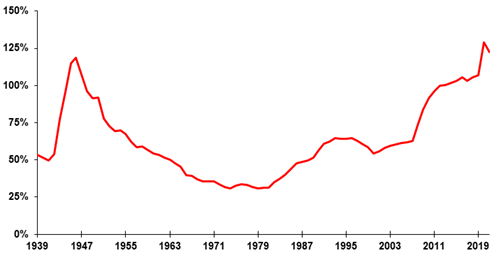S
Subhash Kak
Guest

Engraving of the dragon ouroboros by Lucas Jennis, 1625
The US is robbing from its next generation to support the hegemony of the dollar, which has become a source of structural imbalance in the world economy. Like the mythical ouroboros, it is oblivious that it is eating its own tail.
After World War II, the newly emergent international monetary system centered around the dollar. As it became the major international reserve currency, the US was able to siphon a part of the world’s wealth using seigniorage, which is the profit made by issuing the currency. It is estimated that it costs the US about 17 cents to produce a 100-dollar note, but other countries must pay up 100 dollars worth of actual goods to obtain one.
During the COVID-19 pandemic, the United States injected trillions of dollars into the global market, causing turmoil and uncertainty, leading to high inflation, currency depreciation and increased capital outflows from developing countries.
Costs of dollar hegemony
The figures below show the unprecedented rise in the US total federal public debt and how as a ratio to GDP it has crossed the period of World War II.

US Total Federal Debt in Trillion $

Ratio of US Federal Debt to GDP
The inflation rate is high in the US and there are over 500,000 people who are homeless. Just the city of Los Angeles has nearly 70,000 homeless people, and many of them live on the street because they cannot afford housing. The gap between the rich and the poorer classes has increased, which is contributing to the high level of violence and crime in cities.
Politically, US policy options are limited. Due to the strength of dollar, it can’t compete in manufacturing, which has resulted in a wholesale shutdown of factories during the past decades. The economy is now mostly service, commerce, armaments, and pharma. There are not enough number of good jobs, which is why radical ideas of wokeism are being embraced by the youth. The general malaise is a factor in addiction, and over 100,000 people died of drug overdose last year and this figure has been rising for several years.
The strength of the dollar is evident in the gap between nominal and PPP (purchasing power parity) exchange rates (IMF data):

Nominal and PPP exchange rates

Strength of dollars against other currencies
The US currency is stronger than the two European currencies (pound and dollar) by 1.21 and 1.29; it is stronger by 1.63 than Japanese yen, by 1.86 than Chinese yuan, and by 3.55 than Indian rupee.
The US is an attractive country to immigrate for its wages are higher by the factor related to the strength of the dollar. Thus, for an Indian the typical job in the US will offer 3.55 times the salary back in India.
Happy with control
An easy way to dominate and control someone is through debt or handouts. The US public debt may be $32 trillion, but total global debt exceeds $307 trillion. Unlike the age of colonization, no armies are needed to control other nations; only comprador agents who are easily found in academia and journalism. Likewise, institutions within the US are fearful of going against official wokeism-driven policy — even if it is patently absurd — for fear of losing funding.
The US has exercised hegemony in the international economic and financial sector by taking advantage of the weighted voting systems, and using domestic trade laws and regulations, and the policy of sanctions of individuals, organizations, and nations to force the world to adapt to its view of the future.
For example, in the 1980s, it leveraged its hegemonic financial power for the Plaza Accord with Japan. As a result, the yen was pushed up, and Japan was pressed to open up its financial market and reform its financial system. The Plaza Accord put brakes on the growth momentum of the Japanese economy, that was to the reason for its three lost decades. Now China doesn’t want to fade like Japan did nearly forty years ago.
Where are the trillions of dollars that the US is adding to the deficit going? A large part has gone to the institutional left and special interest groups. Since almost nothing is manufactured in the US, which is obvious from a visit to grocery or department stores), the money finds its way into construction and housing, and thus Americans live in homes that are substantially nicer than in other parts of the world.
At the same time, American schools can’t compete with many other nations (such as China and India) in producing science and mathematics graduates with proper attitudes and skills. It must depend to a large extent on foreign students to provide research and manpower for science and technology industries.
There is not enough incentive to lure Americans into higher education and research. The average salary for a professor is $96,795 per year in the United States; teachers in schools and community colleges often make less than half of this average. On the other hand, in the newly ratified contract for UPS workers, the average driver is slated to earn $170,000 in salary and benefits.
There are many complex reasons why the typical American high school is bad at teaching sciences and math. In part, it is a matter of values. The American media and school curricula relentlessly push consumption and self-gratification. But self-gratification without the guard-rails of morality, ethics, and values becomes a swamp that pulls down individuals.
Alexis de Tocqueville wrote in the Democracy in America: “The greatness of America lies not in being more enlightened than any other nation, but rather in her ability to repair her faults.” This was true when Americans were talking and discussing matters endlessly. Now the pall of cancel culture has descended on the universities, the mainstream press, and social media. During the COVID pandemic, even esteemed scientists were silenced. There is foreboding and fear right now.
Continue reading...
